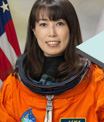JAXA Astronaut Activity Report, May 2010
Last Updated: July 15, 2010
This is JAXA's Japanese astronaut primary activity report for May 2010.
Astronaut Yamazaki’s Homecoming Visit

Astronaut Yamazaki at a media conference (Photo Credit: JAXA)
Astronaut Yamazaki returned to Japan for the first time after completing her mission aboard the space shuttle Discovery (STS-131 mission). While in Japan for about 10 days, she participated in a media conference and a couple of mission debriefing sessions, including a technical debriefing meeting with the JAXA Flight Control Team (JFCT) at the Tsukuba Space Center (TKSC).
During the media conference, Yamazaki talked about the Japanese Experiment Module, Kibo, and mentioned the significance of the technologies and techniques that Japan accumulated during the development of Kibo, saying: “Our technology to support human space flight, our system engineering to integrate multiple systems, such as environment control, power control, and mechanical systems, into a whole, and our technique to assemble more than two million component parts, are extraordinary and remarkable achievements.” She also expressed her aspiration for Japan’s future human space technology development, saying: “It is important for us to set a new goal in order to further advance and utilize our accumulated technologies.”
Yamazaki also visited her hometown, Matsudo City in Chiba prefecture, to participate in the parade and public events Matsudo City hosted and organized in honor of her homecoming.
Kibo, Japanese Experiment Module

Astronaut Furukawa attending a lecture on Kibo’s robotic arm (Photo Credit: JAXA)
Astronaut Furukawa, assigned as an ISS Expedition 28/29 crew member, temporarily returned to Japan to participate in Kibo-specific training at TKSC.
Through lectures and training using the Kibo mockup, Furukawa deepened his knowledge of Kibo’s systems and their operational procedures.
During training on Kibo’s robotic arm, the Japanese Experiment Module Remote Manipulator System (JEMRMS), Furukawa used the simulator of the JEMRMS console and simulated removal/replacement and checkout of the external payloads on Kibo’s Exposed Facility (EF). He also learned how the joints and the tool mechanism of the Small Fine Arm (SFA) would move when being attached to the JEMRMS.
In the training session on science operations on board Kibo, Furukawa reviewed maintenance/cleaning procedures of the Cell Biology Experiment Facility (CBEF) and Clean Bench (CB) that he will perform during his mission. He also learned about the scientific objectives of the JAXA PCG (JAXA’s protein crystal growth experiment) and the Area PADLES (JAXA’s space radiation measurement), as well as other science-related tasks that his fellow crew members will perform.
In addition, he learned the Proximity Communication System (PROX), which is used during rendezvous operations of the H-II Transfer Vehicle (HTV), focusing on its system overview and operational procedures. Between training sessions, he visited TKSC’s on-site processing facility where the components of the HTV-2 are being prepared for launch.
EVA Training at the Neutral Buoyancy Laboratory (NBL)

Astronauts Furukawa (front) and Hoshide (back) preparing for training (Photo Credit: JAXA/NASA)

Astronaut Hoshide checking the lights on the training space suit (Photo Credit: JAXA/NASA)
Astronaut Furukawa, assigned as an Expedition 28/29 crew member, and Astronaut Hoshide, assigned as an Expedition 32/33 crew member, participated in Extravehicular Activity (EVA) training to maintain and enhance their EVA skills at the Neutral Buoyancy Laboratory (NBL) of NASA’s Johnson Space Center (JSC).
Astronaut Candidate (ASCAN) Training

Parabolic flight training (Photo Credit: JAXA/NASA)
Astronaut candidates Yui, Onishi, and Kanai have been continuing their Astronaut Candidate (ASCAN) Training in the United States.
They participated in training on ISS systems, robotic arm operations, and EVA according to their respective training schedules.
During training related to ISS systems, they learned how to operate the Portable Computer System (PCS), which is used for the ISS command & control operations, and the Station Support Computers (SSC), which is used for the station’s operation support, as well as the Electrical Power System (EPS), the Thermal Control System (TCS), and the Environmental Control and Life Support System (ECLSS).
Yui’s training this month mainly focused on EVA gear and tools. He learned how to use the Extravehicular Mobility Unit (EMU), Simplified Aid For EVA Rescue (SAFER), and other EVA tools. Onishi completed training on robotic arm operation and began EVA training this month. Kanai is also ready to start EVA training.
Yui, Onishi, and Kanai participated in a parabolic flight session, which is for trainees to experience simulated microgravity. Along with the above training, the three astronaut candidates continue flight training using a T-38 trainer and Russian language lessons.






